Abstract
Se implementó una unidad para la medición de conductividad eléctrica y efecto Hall, que permite determinar propiedades de transporte en películas metálicas y semiconductoras, tipo de portadores mayoritarios, su concentración y su movilidad, a partir de la medición del voltaje Hall y la corriente. Es claro que para los metales el tipo de portadores son electrones, sin embargo ciertos metales como aluminio, zinc y cadmio entre otros, muestran un comportamiento que clásicamente sería atribuible a portadores de carga positivos (huecos). En el presente trabajo se discuten medidas de efecto Hall en dos tipos de materiales: cobre (Cu) y zinc (Zn). El resultado de las mediciones muestran que el cobre tiene un coeficiente Hall negativo RH = - (0.28 ± 0.01)×10-10 m3/C, mientras que el zinc tiene uno positivo RH = + (4.2 ± 0.2)×10-11 m3/C. Estos resultados son acordes con valores reportados en la literatura. En la mayoría de textos de física del estado sólido no se menciona explícitamente la razón por la cual hay metales que muestran coeficiente Hall positivo. En este trabajo se discute este fenómeno por medio de sus estructuras de bandas.
Palabras clave. Efecto Hall, semiconductor, metal, LabVIEW.
Abstract
We assembled a Hall effect and electric conductivity measuring unit that allows the determination of transport properties in semiconductor and metal films, including the type and concentration of majority carriers and their mobility, from measurements of Hall voltage and current. It is clear that electrons are the charge carrier in metals, however some metals such as aluminum, zinc and cadmium among others exhibit a behavior that, according to the classical view, should be positive charge carriers (holes). In this paper we discuss Hall effect measurements in two types of materials: copper (Cu) and zinc (Zn). Results from measurements show that copper has a negative Hall coefficient RH = - (0.28 ± 0.01)×10-10 m3/C and zinc has a positive coefficient RH = + (4.2 ± 0.2)×10-11 m3/C. Our results agree with those reported in the scientific literature. Most of the textbooks on solid state physics do not mention explicitly the reason why some metals show a positive Hall coefficient. We discuss this fact based on their band structures.
Key words: Hall effect, semiconductor, metal, LabVIEW.Univ. Sci. is registered under a Creative Commons Attribution 4.0 International Public License. Thus, this work may be reproduced, distributed, and publicly shared in digital format, as long as the names of the authors and Pontificia Universidad Javeriana are acknowledged. Others are allowed to quote, adapt, transform, auto-archive, republish, and create based on this material, for any purpose (even commercial ones), provided the authorship is duly acknowledged, a link to the original work is provided, and it is specified if changes have been made. Pontificia Universidad Javeriana does not hold the rights of published works and the authors are solely responsible for the contents of their works; they keep the moral, intellectual, privacy, and publicity rights. Approving the intervention of the work (review, copy-editing, translation, layout) and the following outreach, are granted through an use license and not through an assignment of rights. This means the journal and Pontificia Universidad Javeriana cannot be held responsible for any ethical malpractice by the authors. As a consequence of the protection granted by the use license, the journal is not required to publish recantations or modify information already published, unless the errata stems from the editorial management process. Publishing contents in this journal does not generate royalties for contributors.



